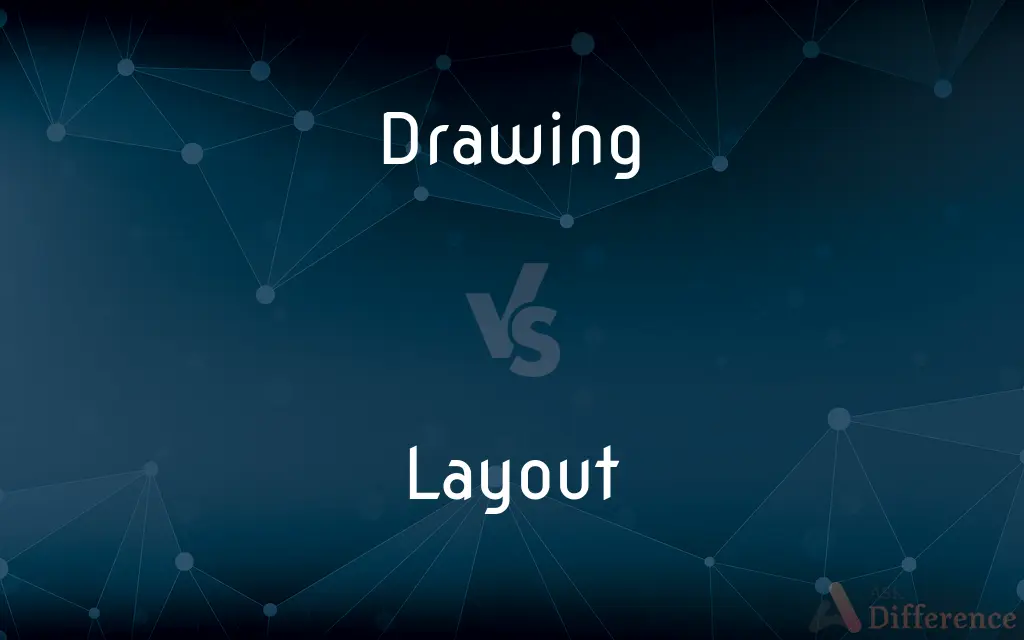Drawing vs. Layout — What's the Difference?
By Tayyaba Rehman & Maham Liaqat — Updated on March 26, 2024
Drawing involves creating art or representations through lines, while a layout focuses on arranging elements within a design for clarity and effectiveness.

Difference Between Drawing and Layout
Table of Contents
ADVERTISEMENT
Key Differences
Drawing is the act of marking surfaces with pens, pencils, or other tools to create visual art, diagrams, or designs, emphasizing artistic expression or technical precision. It can represent real-life objects, abstract concepts, or visual ideas. On the other hand, a layout pertains to the process of arranging visual elements in a space, such as a page or screen, focusing on the organization for aesthetic or functional purposes. This includes the placement of text, images, and other components to ensure optimal communication and visual appeal.
While drawing is often a foundational skill for creating individual elements within a layout, such as illustrations or graphical icons, layout design involves a broader understanding of visual hierarchy, typography, and spatial relationships. Drawing creates the visual content, whereas layout determines how that content is organized and presented to the viewer.
In drawing, the artist or designer focuses on line quality, shading, and composition to bring ideas to life. It's a skill that requires a deep understanding of form, perspective, and shadow. Conversely, creating a layout involves decisions about color schemes, font choices, and the balance between different elements to guide the viewer's eye and convey information effectively.
The purpose of drawing can vary widely, from artistic expression to the detailed planning of architectural designs. Layout, however, consistently aims to enhance readability, navigability, and aesthetics in mediums such as websites, magazines, and brochures. The effectiveness of a layout is measured by how well it communicates its intended message and guides the viewer through the content.
Despite their differences, drawing and layout are interconnected disciplines in the fields of art and design. A strong drawing can enhance a layout by adding unique visual elements, while an effective layout can showcase drawings in a more compelling and organized manner. Both require a thoughtful approach to composition and an understanding of visual principles.
ADVERTISEMENT
Comparison Chart
Definition
Creating representations through lines and marks.
Arranging elements in a space for design purposes.
Focus
Artistic expression, technical representation.
Organization, clarity, aesthetic arrangement.
Skills
Line quality, shading, perspective.
Typography, visual hierarchy, color theory.
Purpose
To depict objects, ideas, or scenes.
To enhance communication, readability, aesthetics.
Outcome
Visual art, design elements.
Coherent, effective visual presentations.
Compare with Definitions
Drawing
Creating representations with lines or marks.
Drawing accurate anatomy requires practice.
Layout
Organizing content for clarity and impact.
A good layout balances text, images, and whitespace.
Drawing
Technique of depicting visual elements.
Drawing landscapes helps understand perspective.
Layout
Structuring information to guide the viewer.
Effective layout directs the reader's eye through the content.
Drawing
The act of producing images on a surface.
She spent her afternoon drawing portraits.
Layout
Planning the placement of visual components.
The brochure's layout was visually appealing.
Drawing
A preliminary sketch for future work.
The architect's drawing outlined the new building's design.
Layout
Designing the structure for printed or digital pages.
She excels in layout design for websites.
Drawing
Expressing ideas through graphical means.
His drawings convey emotions powerfully.
Layout
The arrangement of elements on a page or screen.
The magazine's layout made articles easy to read.
Drawing
Drawing is a form of visual art in which an artist uses instruments to mark paper or other two-dimensional surface. Drawing instruments include graphite pencils, pen and ink, various kinds of paints, inked brushes, colored pencils, crayons, charcoal, chalk, pastels, erasers, markers, styluses, and metals (such as silverpoint).
Layout
The way in which the parts of something are arranged or laid out
The road layout
Drawing
The act or an instance of drawing.
Layout
The act or an instance of laying out.
Drawing
The art of representing objects or forms on a surface chiefly by means of lines.
Layout
An arrangement or plan, especially the schematic arrangement of parts or areas
The layout of a factory.
The layout of a printed circuit.
Drawing
A work produced by this art.
Layout
The art or process of arranging printed or graphic matter on a page.
Drawing
Present participle of draw
Layout
The overall design of a page, spread, or book, including elements such as page and type size, typeface, and the arrangement of titles and page numbers.
Drawing
A picture, likeness, diagram or representation, usually drawn on paper.
Layout
A page or set of pages marked to indicate this design.
Drawing
The act of producing such a picture.
Layout
(Sports) The straight position, as in diving.
Drawing
Such acts practiced as a graphic art form.
Layout
(Informal) An establishment or property, especially a large residence or estate
"[Her] show horses ... were kept on the couple's one-and-a-half acre Malibu layout" (People).
Drawing
The process of drawing or pulling something.
Proverb: An official is great in his office as a well is rich in drawings of water.
Layout
A structured arrangement of items within certain limits.
Drawing
An act or event in which the outcome (e.g., designating a winner) is selected by chance in the form of a blind draw, notably of lots; especially such a contest in which a winning name or number is selected randomly by removing (or drawing) it from a container, popularly a hat.
Layout
A plan for such arrangement.
Drawing
A small portion of tea for steeping.
Layout
The act of laying out something.
Drawing
The act of pulling, or attracting.
Layout
(publishing) The process of arranging editorial content, advertising, graphics and other information to fit within certain constraints.
Drawing
The act or the art of representing any object by means of lines and shades; especially, such a representation when in one color, or in tints used not to represent the colors of natural objects, but for effect only, and produced with hard material such as pencil, chalk, etc.; delineation; also, the figure or representation drawn.
Layout
(engineering) A map or a drawing of a construction site showing the position of roads, buildings or other constructions.
Drawing
The process of stretching or spreading metals as by hammering, or, as in forming wire from rods or tubes and cups from sheet metal, by pulling them through dies.
Layout
(electronics) A specification of an integrated circuit showing the position of the physical components that will implement the schematic in silicon.
Drawing
The process of pulling out and elongating the sliver from the carding machine, by revolving rollers, to prepare it for spinning.
Layout
A plan or design of something that is laid out
Drawing
The distribution of prizes and blanks in a lottery.
Layout
The act of laying out (as by making plans for something)
Drawing
An illustration that is drawn by hand and published in a book or magazine;
It is shown by the drawing in Fig. 7
Drawing
A representation of forms or objects on a surface by means of lines;
Drawings of abstract forms
He did complicated pen-and-ink drawings like medieval miniatures
Drawing
The creation of artistic drawings;
He learned drawing from his father
Drawing
Players buy (or are given) chances and prizes are distributed according to the drawing of lots
Drawing
Act of getting or draining something such as electricity or a liquid from a source;
The drawing of water from the well
Drawing
The act of moving a load by drawing or pulling
Common Curiosities
How does layout affect design?
Layout affects design by organizing visual elements in a coherent, aesthetically pleasing manner, enhancing readability and the overall effectiveness of the communication.
What skills are essential for layout design?
Essential skills for layout design include understanding typography, color theory, visual hierarchy, and spatial relationships.
How does technology impact layout design?
Technology offers tools and software that streamline the layout design process, enable complex visual effects, and facilitate testing different arrangements efficiently.
What is the primary goal of drawing?
The primary goal of drawing is to create visual representations through lines and marks, focusing on artistic expression or technical accuracy.
Can layout design exist without drawing?
Yes, layout design can exist without traditional drawing, especially in digital contexts, but it often incorporates drawings or graphical elements to improve visual appeal.
Why is drawing important in design?
Drawing is important in design for creating original visual content, conceptualizing ideas, and enhancing the visual quality of the layout.
How do drawings enhance layouts?
Drawings enhance layouts by adding unique visual elements, contributing to the theme, and engaging the viewer's attention.
How do cultural differences affect layout design?
Cultural differences can affect layout design preferences in terms of color, symbolism, and spatial organization, requiring designers to adapt to diverse audiences.
Can someone be good at layout but not at drawing?
Yes, it's possible to excel in layout design with a strong sense of visual organization and aesthetics, even without advanced drawing skills.
What makes a good layout?
A good layout is clear, visually balanced, and effectively guides the viewer's eye, ensuring that the content is accessible and engaging.
Is drawing necessary for all designers?
While not strictly necessary for all design fields, drawing is a valuable skill that can enhance a designer's ability to visualize and communicate ideas.
What are common challenges in layout design?
Common challenges include balancing aesthetic appeal with functionality, aligning the layout with the content's purpose, and ensuring accessibility for all users.
Why are drawing and layout considered fundamental in art and design?
Drawing and layout are fundamental in art and design because they underpin the creation and organization of visual content, influencing how ideas are communicated and perceived.
What role does psychology play in layout design?
Psychology plays a significant role in layout design by informing how visual elements are perceived and processed, influencing attention and emotional response.
How has digital media changed drawing and layout practices?
Digital media has expanded the tools available for both drawing and layout, facilitating innovation, collaboration, and the integration of multimedia elements.
Share Your Discovery

Previous Comparison
Kurma vs. Korma
Next Comparison
Poetry vs. PoemAuthor Spotlight
Written by
Tayyaba RehmanTayyaba Rehman is a distinguished writer, currently serving as a primary contributor to askdifference.com. As a researcher in semantics and etymology, Tayyaba's passion for the complexity of languages and their distinctions has found a perfect home on the platform. Tayyaba delves into the intricacies of language, distinguishing between commonly confused words and phrases, thereby providing clarity for readers worldwide.
Co-written by
Maham Liaqat













































